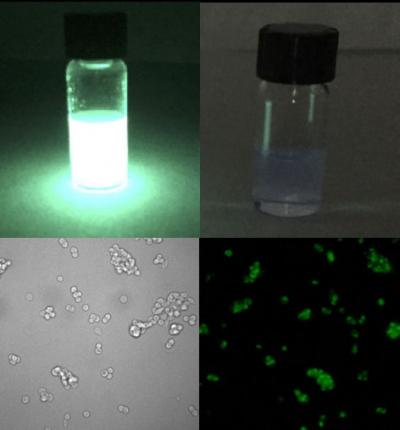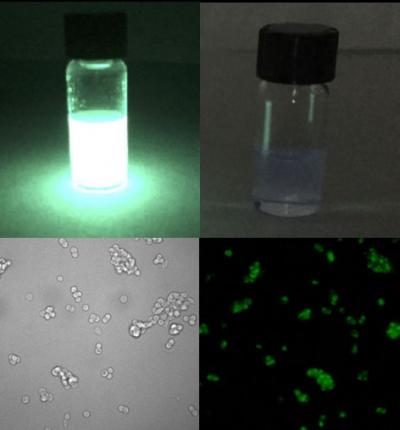
Credit: American Chemical Society
Any child who has played with a glowstick or captured a firefly understands the wonder of chemiluminescence, or chemical light. This process is already used to detect blood at crime scenes and to determine the concentrations of different components of biological samples. This week in ACS Central Science, researchers introduce a new chemiluminescent probe that is better for use in water and up to 3,000 times brighter than previous probes.
Chemiluminescent probes are among the most sensitive diagnostic tools for DNA sequencing, crime scene analysis and immunoassays. Most systems use a cocktail with one emitter molecule that detects the species of interest by giving off weak light, and another two additional ingredients — a fluorophore and a soap-like substance called a surfactant — that amplify the signal to detectable levels. However, energy is lost in the transfer process from one molecule to the other, and surfactants are not biocompatible. Doron Shabat and colleagues proposed that by tweaking the electronic structure of current probes to improve their inherent fluorescence, they could create a new single-component emission system that would work for many applications.
The researchers investigated many variants of the most-common emitter molecule by swapping out elements and testing the resulting changes in emission. Shabat and colleagues found that, in one instance, simply adding two key atoms resulted in a much brighter probe than those currently on the market. In addition, this particular molecule is suitable for direct use in cells. Based on this molecule, the researchers developed sensors to detect several biologically relevant chemicals. They also used the chemiluminescent molecule to measure the activity of several enzymes and to image cells by microscopy — something that had previously required the genetic engineering of the firefly's enzymatic machinery. They say that scientists will now have in hand a new powerful methodology to prepare highly efficient chemiluminescence sensors for detection and imaging of various cell activities and analytes.
###
The authors acknowledge funding from the Israel Science Foundation, the Binational Science Foundation, the German Israeli Foundation and the Israeli National Nanotechnology Initiative.
The paper will be freely available on March 8th here: http://pubs.acs.org/doi/full/10.1021/acscentsci.7b00058
The American Chemical Society is a nonprofit organization chartered by the U.S. Congress. With nearly 157,000 members, ACS is the world's largest scientific society and a global leader in providing access to chemistry-related research through its multiple databases, peer-reviewed journals and scientific conferences. ACS does not conduct research, but publishes and publicizes peer-reviewed scientific studies. Its main offices are in Washington, D.C., and Columbus, Ohio.
To automatically receive news releases from the American Chemical Society, contact [email protected].
Follow us: Twitter | Facebook
Media Contact
ACS Newsroom
[email protected]
Katie Cottingham
[email protected]
301-775-8455
############
Story Source: Materials provided by Scienmag





